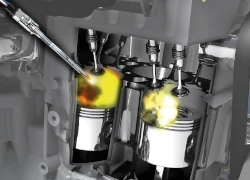A marine diesel engine is a reciprocating piston engine that ignites a compressed fuel-air mixture to create a force that pushes down on the pistons and in turn push against the crankshaft. This force creates rotational energy which can be
used to drive a generator or a propellor. Unlike petrol engines, diesel engines do not need a spark plug to ignite the fuel-air mixture, rather the mixture auto ignites when a certain pressure and temperature is reached. This simplicity
makes them very suitable for use in a marine environment where dependence on electrical signals can be problematic.
A diesel engine has two main requirements:
Although an engine can appear complex, at its heart, fuel and air are its fundamental requirements.
Lets work through the engine sequence.
Creating an effective power stroke is not just a case of adding fuel and air and compressing it until it ignites. There is a specific ratio air to fuel for ignition to occur and you need a sufficient volume of that mix to be in the cylinder to create enough force to push the cylinder down. For the most efficient combustion, the amount of air in the combustion chamber is 14.5 times that of diesel, by weight.

Whilst the engine will operate with a small deviation from the ideal ratio,
it will run inefficiently and may produce smoke, or operate with less power. Diesel will ignite in excess air, however with the fixed volume inside the cylinder, excess air means less fuel. This means less power to drive the cylinder.
If the amount of fuel supplied is too low, the engine will stall as it no longer has enough power to drive one of the other cylinders into the ignition stroke. If there is excess fuel, the power delivered by each stroke will be less, and
eventually it will be unable to ignite when compressed causing the engine to be unable to run.
To ensure efficient combustion and reliable operation, both the engines air system and fuel system need to be working properly. Through out the course we will cover the checks recommended that should ensure clean combustion,
and how to recognise when a problem is occurring.
